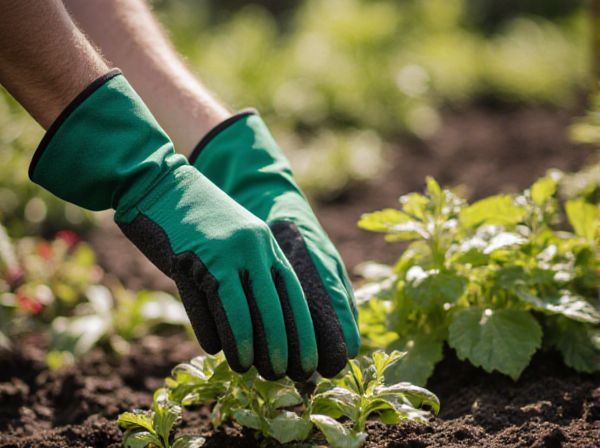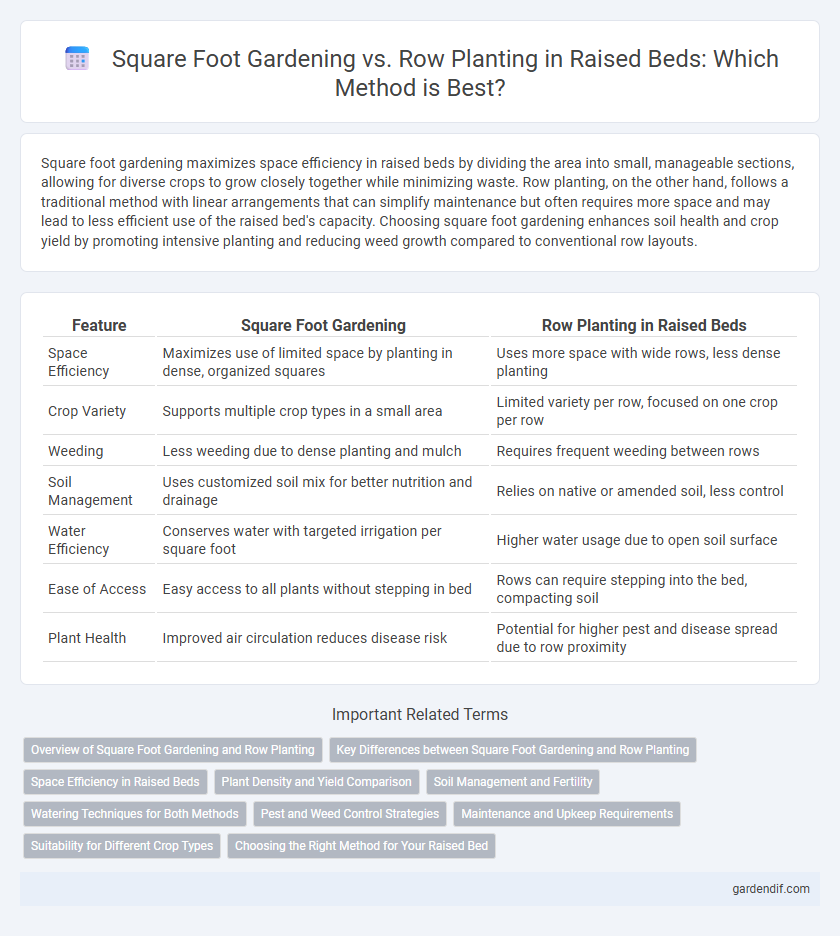
Square foot gardening vs row planting in raised beds Illustration
Square foot gardening maximizes space efficiency in raised beds by dividing the area into small, manageable sections, allowing for diverse crops to grow closely together while minimizing waste. Row planting, on the other hand, follows a traditional method with linear arrangements that can simplify maintenance but often requires more space and may lead to less efficient use of the raised bed's capacity. Choosing square foot gardening enhances soil health and crop yield by promoting intensive planting and reducing weed growth compared to conventional row layouts.
Table of Comparison
| Feature | Square Foot Gardening | Row Planting in Raised Beds |
|---|---|---|
| Space Efficiency | Maximizes use of limited space by planting in dense, organized squares | Uses more space with wide rows, less dense planting |
| Crop Variety | Supports multiple crop types in a small area | Limited variety per row, focused on one crop per row |
| Weeding | Less weeding due to dense planting and mulch | Requires frequent weeding between rows |
| Soil Management | Uses customized soil mix for better nutrition and drainage | Relies on native or amended soil, less control |
| Water Efficiency | Conserves water with targeted irrigation per square foot | Higher water usage due to open soil surface |
| Ease of Access | Easy access to all plants without stepping in bed | Rows can require stepping into the bed, compacting soil |
| Plant Health | Improved air circulation reduces disease risk | Potential for higher pest and disease spread due to row proximity |
Overview of Square Foot Gardening and Row Planting
Square Foot Gardening maximizes space by dividing raised beds into small, manageable square sections, each dedicated to a specific crop, enhancing plant density and reducing weed growth. Row planting in raised beds follows traditional linear layouts, allowing for easier planting of larger crops but often using more space and requiring more maintenance. Both methods support efficient use of raised beds but differ in spatial optimization and crop variety suitability.
Key Differences between Square Foot Gardening and Row Planting
Square foot gardening optimizes space by dividing raised beds into one-foot squares, allowing dense planting and efficient use of nutrients, water, and sunlight. Row planting in raised beds follows traditional linear spacing, which can require more space and may lead to less efficient use of soil and resources. The key differences lie in planting density, resource efficiency, and space management, with square foot gardening promoting high yield per square foot compared to the more spaced and accessible rows of traditional planting.
Space Efficiency in Raised Beds
Square foot gardening maximizes space efficiency in raised beds by dividing the bed into small, manageable sections that allow precise planting of multiple crops per square foot. Row planting often results in wasted space due to wider row spacing and unused gaps between plants. Optimizing plant density with square foot gardening increases yield and reduces soil disturbance within the limited space of raised beds.
Plant Density and Yield Comparison
Square foot gardening in raised beds maximizes plant density by dividing the bed into one-foot squares, allowing for intensive planting and efficient use of space. Row planting typically spaces crops farther apart, resulting in lower plant density but easier access for maintenance and harvesting. Studies show square foot gardening yields higher produce per square foot due to closer plant spacing and optimized nutrient use.
Soil Management and Fertility
Square foot gardening in raised beds maximizes soil management by dividing the bed into small, manageable sections, ensuring precise soil amendment and targeted fertilizer application, which enhances nutrient availability and minimizes waste. In contrast, row planting often requires broader soil preparation and uniform fertilizer distribution, potentially leading to less efficient nutrient uptake and increased soil compaction. Effective soil fertility management in square foot gardening promotes better root development and higher crop yields compared to traditional row planting methods.
Watering Techniques for Both Methods
Square foot gardening in raised beds optimizes water use by concentrating irrigation within dense planting grids, reducing water waste and promoting deep root hydration through targeted drip or soaker hoses. Row planting requires consistent, evenly spaced watering zones to ensure uniform soil moisture along linear rows, often benefiting from overhead irrigation or furrow watering techniques. Both methods emphasize efficient water management by matching irrigation delivery to planting density and root depth, minimizing evaporation and runoff.
Pest and Weed Control Strategies
Square foot gardening in raised beds enhances pest and weed control by allowing dense planting and precise spacing, which reduces open soil exposure where weeds typically grow. Row planting increases susceptibility to pests and weeds due to larger bare soil areas and less plant diversity, creating a more accessible habitat for pests. Effective pest management in square foot gardening includes crop rotation and companion planting, while row planting often requires regular mechanical weeding and targeted pesticide use.
Maintenance and Upkeep Requirements
Square foot gardening in raised beds requires less maintenance due to concentrated planting, which reduces weeding and watering efforts. Row planting demands more frequent upkeep as wider spacing allows weeds to proliferate and necessitates regular soil cultivation. Efficient water usage and minimal pest management make square foot gardening an ideal method for low-maintenance raised bed cultivation.
Suitability for Different Crop Types
Square foot gardening in raised beds maximizes space efficiency and is ideal for small, slow-growing crops like leafy greens, herbs, and root vegetables. Row planting suits larger, spreading plants such as tomatoes, peppers, and cucumbers that require more room for roots and vines. Choosing between these methods depends on crop spacing needs and growth habits to optimize yield and plant health in raised beds.
Choosing the Right Method for Your Raised Bed
Square foot gardening maximizes space efficiency by dividing raised beds into precise one-foot sections for dense, organized planting, ideal for small areas. Row planting offers traditional crop rows that simplify maintenance and are better suited for larger beds or plants requiring more space. Selecting the right method depends on garden size, plant types, and maintenance preferences to optimize yield and ease of care.
Square foot gardening vs row planting in raised beds Infographic

 gardendif.com
gardendif.com